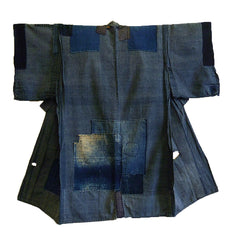A Wonderfully Patched Boro Kimono: 19th Century Sankuzushi Cotton
mid to late nineteenth century
43 1/2" x 45", 110.5 cm x 114.25 cm
This old kimono is made from a type of woven cotton cloth which was popular in mid-to-late nineteenth Japan. The pattern is a resembles basket weave or a "split bamboo mat." Referred to as sankuzushi, this "woven" pattern which was produced in myriad variation. In this case, the scale of the sankuzushi pattern is very small. Sometimes the pattern is larger, sometimes it is shown mixed in with plaids.
Sankuzushi seems to have its origin in India; it seems to have then been adapted by the Chinese. No wonder this beautiful cloth found its way to Japan and was produced there by native hands.
Because of this sankuzushi cloth we know this is an old kimono.
It is shown here inside-out because the beautiful and artful patching and mending is most noticeable this way. Also, what is quite easy to see is that the kimono also shows several good-sized holes, not so difficult to understand since this is quite an old kimono.
The patching is well-placed, and perhaps most interesting are the two-large patches at what would have been the "seat" of the kimono--reinforcement was put here because the nature of Japanese movements, all related to spending so much time kneeling on the floor, tend to strain the seam of the kimono at this place.
For those interested in a very beautifully patched boro kimono with good age, this is most definitely one to consider.
A beauty.
Recommended.

